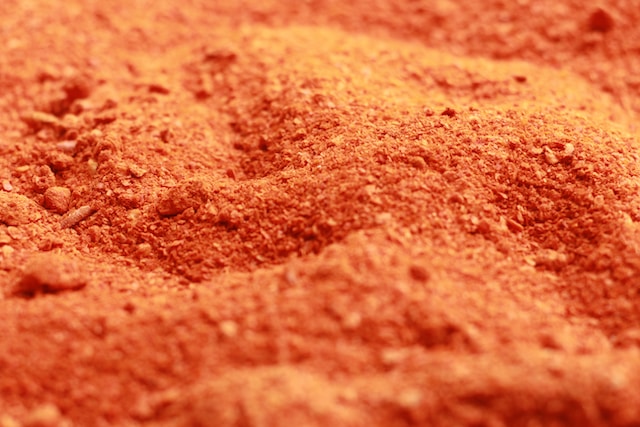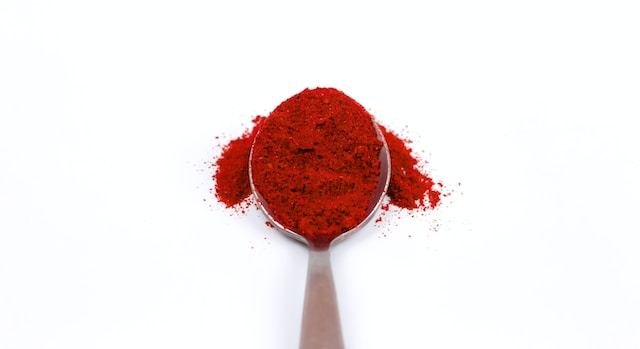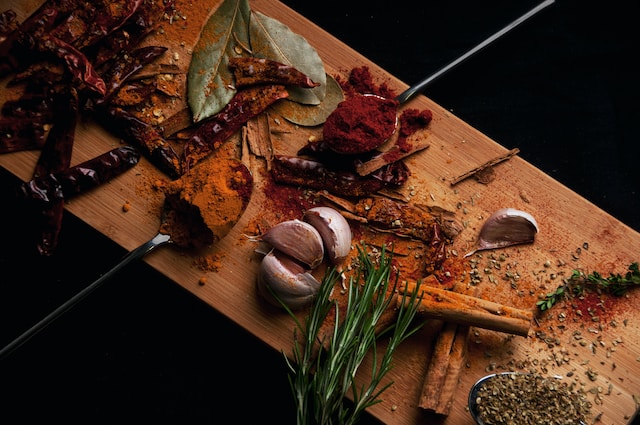Are you ready to add a burst of flavor and a vibrant touch to your dishes? Look no further than paprika, the spice that brings a world of taste and color to your culinary adventures. From its humble beginnings to its global popularity, paprika has become a staple in kitchens around the world. But what exactly is paprika, and why should it be an essential ingredient in your pantry? In this blog, we will dive into the origins, varieties, and incredible benefits of paprika, unlocking its secrets and inspiring you to unleash your creativity in the kitchen. So, grab your apron, and let’s start revealing the types of paprika!
Major Health Benefits of Paprika

Paprika is not only a flavorful spice but also has several positive effects on our health. One of the major advantages is its high antioxidant content. Antioxidants play a crucial role in protecting our cells from damage caused by free radicals, which can lead to chronic diseases like heart disease and cancer. So, adding paprika to your dishes can help give your body a boost of these protective compounds.
Another fantastic component of paprika is capsaicin, the compound responsible for its spicy taste. Capsaicin has been found to have anti-inflammatory properties, meaning it can help reduce inflammation in the body and alleviate associated symptoms. Plus, it’s been linked to a boost in metabolism and weight loss by increasing fat-burning and curbing appetite. So, if you’re looking to shed a few pounds or reduce inflammation, paprika can be a helpful addition to your meals.
But that’s not all! Paprika is also a good source of essential vitamins and minerals. It contains vitamin A, which is essential for maintaining healthy vision, supporting the immune system, and promoting skin health. Vitamin E is another key nutrient found in paprika, acting as a potent antioxidant and contributing to overall well-being. Additionally, paprika provides iron, a mineral crucial for the production of red blood cells and the transport of oxygen throughout the body.
By incorporating paprika into your diet, you can enjoy not only its delicious flavor but also reap the various health benefits it offers. So, don’t hesitate to sprinkle some paprika on your dishes and savor its taste while promoting your well-being.
Types of Paprika You Can Use for Various Dishes

1. Noble Sweet Paprika
This type of paprika is the highest quality and most flavorful variety. It is from a specific type of sweet pepper “Noble Sweet” or “Kalocsa,” which is cultivated in Hungary. Noble Sweet Paprika has a rich, fruity flavor and a vibrant red color. It is often used as a finishing spice to enhance the visual appeal of dishes.
2. Rose Paprika
Also known as Pimento Paprika, Rose Paprika is made from the sweet and aromatic Pimento pepper. It has a distinctive fruity flavor and a deep red color. Rose Paprika is commonly used in Caribbean and Latin American cuisines to add a mild heat and flavor to stews, sauces, and grilled meats.
3. Turkish Paprika
This type of paprika is from Turkey and is popular for its bright red color and bold flavor. Turkish paprika can range from mild to hot, and it is often present in Turkish dishes like kebabs, soups, and pilafs. It adds a robust, earthy flavor to the dishes.
4. California Paprika
California paprika is made from the Anaheim pepper, a mild chili pepper grown in California. It has a bright red color and a slightly sweet and tangy flavor. California paprika is often used as a garnish or for mild seasoning in various dishes.
5. Polish Paprika
Polish paprika, also known as Papryka, is a popular spice in Polish cuisine. It is made from a combination of sweet and hot peppers, resulting in a balanced flavor profile. Polish paprika adds mild heat and rich red color to dishes like sausages, stews, and goulash.
6. Portuguese Paprika
In Portugal, paprika is known as Pimentão Doce and is widely used in traditional dishes. Portuguese paprika is from sweet peppers and has a slightly sweet and smoky flavor. It is often present in marinades, soups, and seafood dishes.
7. Indian Paprika
Paprika is the same as Kashmiri chili powder in Indian cuisine. It is from dried red Kashmiri chilies and has a vibrant red color with a medium level of spiciness. Indian paprika’s use is to add heat and color to curries, tandoori dishes, and various Indian snacks.
8. Mexican Paprika
Mexican paprika, also known as Pimentón Mexicano, is made from a variety of chili peppers, such as Ancho, Guajillo, or Pasilla. It has a deep red color and a mild to medium heat level. Mexican paprika is a staple in Mexican cuisine, used in dishes like mole sauces, chili con carne, and enchiladas.
9. Korean Paprika
In Korean cuisine, paprika is called “Gochugaru.” It is made from sun-dried red chili peppers and has a vibrant red color. Korean paprika is often used to make kimchi, spicy stews, and various spicy side dishes. It has a medium level of spiciness and a slightly smoky flavor.
10. Japanese Paprika
In Japan, paprika is known as “Papurika” and is used as a seasoning in various dishes. Japanese paprika is from dried red chili peppers and has a bright red color with a mild to moderate level of spiciness. It is commonly present in ramen, stir-fries, and marinades.
11. Moroccan Paprika
Moroccan paprika, also known as “Ras el Hanout,” is a blend of various spices, including paprika, cumin, coriander, ginger, and cinnamon. It has a complex flavor profile with a hint of sweetness and a mild to moderate level of spiciness. Moroccan paprika is often used in tagines, couscous, and other Moroccan dishes.
12. South American Paprika
In South American cuisine, paprika is widely used to add flavor and color to dishes. Different countries in South America have their own variations of paprika, often made from local chili peppers. It is used in dishes like empanadas, grilled meats, and sauces.
13. African Paprika
Paprika is also used in various African cuisines. In North African cuisine, a popular paprika blend called “Harissa” is used, which combines paprika with other spices like cumin, coriander, and caraway. In West African cuisine, ground peppers are used as a spice to add heat and flavor to stews, soups, and grilled meats.
14. Middle Eastern Paprika
In Middle Eastern cuisine, paprika is often present in spice blends like “Za’atar” and “Baharat.” These blends typically include paprika along with herbs, sesame seeds, and other spices. Middle Eastern paprika adds a warm, earthy flavor to dishes like grilled meats, roasted vegetables, and dips.
These are just a few examples of the different types of paprika found around the world. Each type has its own unique characteristics, flavors, and culinary uses, making paprika a versatile spice with a wide range of applications in global cuisine.
Popular Culinary Uses of Paprika

Seasoning and garnishing: Paprika is a versatile spice that can be used as a seasoning and garnish in various dishes. It adds a mild, sweet, or spicy flavor, depending on the type of paprika used. Sprinkle it over roasted vegetables, grilled meats, rice dishes, or even popcorn to enhance their taste and visual appeal.
🟩 Spice rubs and marinades
Paprika is a popular ingredient in spice rubs and marinades for meats, poultry, and seafood. Combined with other spices like cumin, coriander, or oregano, it creates a flavorful coating or marinade that infuses the dish with a rich, smoky, or slightly pungent taste.
🟩 Hungarian dishes
Paprika holds a special place in Hungarian cuisine, where it is prominent as the national spice. It is a key ingredient in iconic Hungarian dishes like goulash, a hearty meat and vegetable stew, and chicken paprikash, a flavorful chicken dish cooked in a paprika-infused sauce. Hungarian paprika varieties, such as “Noble sweet” or “Hot Hungarian,” are popular for their distinct flavor profiles and are commonly present in these recipes.
🟩 Spanish cuisine
Paprika, or “pimentón” in Spanish, is widely present in Spanish cooking. It adds a vibrant color and smoky flavor to dishes like paella, a saffron-infused rice dish, chorizo, a spicy sausage, and various tapas. Spanish paprika is available in three types: sweet (dulce), bittersweet (agridulce), and hot (picante), each with its own level of heat and flavor intensity.
🟩 Soups and stews
Paprika is a fantastic addition to soups and stews, providing depth and complexity to the flavors. Whether it’s a classic tomato soup, a hearty beef stew, or a spicy chili, you can add it to the broth or seasoning blend to enhance the taste and give the dish a warm, reddish hue.
🟩 Deviled eggs
You can use paprika as a garnish for deviled eggs, a popular appetizer, or a snack. Sprinkling paprika over the creamy egg yolk filling not only adds a touch of color but also imparts a subtle smoky flavor that complements the richness of the dish.
🟩 Spice blends and seasonings
Paprika is a key ingredient in various spice blends and seasonings, lending its unique flavor to the overall profile. It is an essential component in spice blends like Cajun seasoning, adding a hint of smokiness and heat. Paprika is also a part of chili powder, curry powder, and other spice blends, contributing to their distinctive tastes.
🟩 Dips and spreads
You can incorporate paprika into dips and spreads, bringing a delightful flavor and color. You can also mix it into hummus, giving it a slightly smoky or spicy kick. Paprika is also used in salsa, adding a touch of warmth and complexity to the tomato-based dip. Yogurt-based sauces, such as tzatziki or raita, can benefit from a sprinkle of paprika, enhancing both taste and appearance.
🟩 Baked goods
While not as common as other uses, paprika can be used to add a subtle smoky or sweet flavor to baked goods. You can incorporate it into bread, savory pastries, or even sprinkle it over potato dishes like gratins or roasted potatoes for an extra touch of taste and color.
Remember that the various types of paprika, such as sweet, hot, smoked, and Hungarian, each offer unique flavors and intensities. Feel free to experiment with different types to find the one that best suits your preferences and the specific dish you’re preparing.
Proper Storage and Preservation for Longer Use
🟦 Choose airtight containers
When storing paprika, it’s important to transfer it to airtight containers. Glass jars with tight-fitting lids or resealable bags work well for this purpose. Airtight containers help to prevent air and moisture from entering, which can degrade the flavor and quality of the spice over time.
🟦 Store in a cool, dark place
You should store paprika in a cool, dry, and dark location. Exposure to sunlight and heat can cause the spice to lose its flavor, color, and potency. Choose a storage area away from direct sunlight and heat sources like stoves or ovens. Ideally, a pantry or cupboard is an appropriate place for storing paprika.
🟦 Avoid humidity
Moisture is one of the biggest enemies of paprika. It can cause the spice to clump together or develop mold. To prevent this, ensure that the storage area is dry. Avoid storing paprika near any damp areas in your kitchen, such as sinks or dishwashers.
🟦 Keep away from strong odors
Paprika has a tendency to absorb odors from other spices and strong-smelling substances. To maintain its own distinct flavor and aroma, store paprika separately or in a well-sealed container. This will prevent it from picking up unwanted odors from other ingredients in your kitchen.
🟦 Don’t store it near the stove
Heat is another factor that can degrade the quality of paprika. Avoid storing it near the stove or any other heat source in your kitchen. The heat generated during cooking can cause the spice to lose its potency and flavor more quickly.
🟦 Check for freshness
Paprika, like any other spice, has a limited shelf life. While it won’t necessarily spoil, it can lose its flavor and vibrancy over time. Check the packaging or container for an expiration date, if available. If there is no expiration date, use the general guideline of using paprika within 1 to 3 years for best quality. Additionally, if the spice has lost its vibrant red color and has a dull appearance, it’s likely past its prime and may not provide the desired flavor.
🟦 Whole paprika vs. ground paprika
Whole dried paprika peppers have a longer shelf life compared to ground paprika. This is because the grinding process exposes more surface area to air and hastens the oxidation process. To maximize the freshness of your paprika, consider buying whole peppers and grinding them as needed. You can store paprika n the same manner as ground paprika. Transfer it to airtight containers and store it in a cool, dark place.
By following these expanded storage guidelines, you can ensure that your paprika retains its flavor, color, and quality for a longer period, enhancing your culinary creations with its vibrant taste.
Final Words
In conclusion, paprika is not just a humble spice in kitchen cabinets; it is a vibrant ingredient that adds depth, flavor, and color to a variety of dishes. Its rich history, ranging from its origins in Central and South America to its adoption and transformation in different cuisines around the world, speaks to its versatility and global appeal.
Whether you’re sprinkling it over roasted vegetables for a smoky kick, using it as a key component in traditional dishes like Hungarian goulash, or incorporating it into your homemade spice blends, paprika has the power to elevate your culinary creations to new heights.
Remember, paprika is more than just a seasoning; it’s a symbol of culinary exploration, cultural fusion, and a reminder that the world’s greatest flavors often lie in the simplest of spices. So, embrace the paprika and let it infuse your dishes with its unique and tantalizing essence. Bon appétit!
To know more about paprika, just click here!
